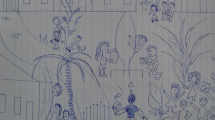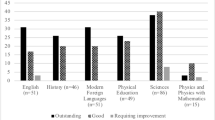Abstract
The aim of this exploratory study was to learn about the misconceptions that may arise for elementary and high school science teachers in their reflections on science and engineering practice. Using readings and videos of real science and engineering work, teachers’ reflections were used to uncover the underpinnings of their understandings. This knowledge ultimately provides information about supporting professional development (PD) for science teachers’ knowledge of engineering. Six science teachers (two elementary and four high school teachers) participated in the study as part of an online PD experience. Cunningham and Carlsen’s (Journal of Science Teacher Education 25:197–210, 2014) relative emphases of science and engineering practices were used to frame the design of PD activities and the analyses of teachers’ views. Analyses suggest misconceptions within the eight practices of science and engineering from the US Next Generation Science Standards in four areas. These are that: (1) the nature of the practices in both science and engineering research is determined by the long-term implications of the research regardless of the nature of the immediate work, (2) engineering and science are hierarchical, (3) creativity is inappropriate, and (4) research outcomes cannot be processes. We discuss the nature of these understandings among participants and the implications for engineering education PD for science teachers.

Similar content being viewed by others
References
Abd-El-Khalick, F., & Lederman, N. G. (2000). Improving science teachers’ conceptions of nature of science: A critical review of the literature. International Journal of Science Education, 22, 665–701.
Anderson, G. L., Herr, K., & Nihlen, A. S. (1994). Studying your own school. Thousand Oaks, CA: Corwin.
Apedoe, X. S., Reynolds, B., Ellefson, M. R., & Schunn, C. D. (2008). Bringing engineering design into high school science classrooms: The heating/cooling unit. Journal of Science Education and Technology, 17, 454–465.
Ball, P. (2013). Insect leg cogs a first in animal kingdom. Nature. doi:10.1038/nature.2013.13723.
Banilower, E. R., Smith, P. S., Weiss, I. R., Malzahn, K. A., Campbell, K. M., & Weis, A. M. (2013). Report of the 2012 national survey of science and mathematics education. Chapel Hill: Horizon Research.
Brown, J., Brown, R., & Merrill, C. (2012). Science and technology educators’ enacted curriculum: Areas of possible collaboration for an integrative STEM approach in public schools. Technology and Engineering Teacher, 71(4), 30–34.
Brown, S., & Melear, C. (2007). Preservice teachers’ research experiences in scientists’ laboratories. Journal of Science Teacher Education, 18, 573–597.
Capps, D. K., Crawford, B. A., & Constas, M. A. (2012). A review of empirical literature on inquiry professional development: Alignment with best practices and a critique of the findings. Journal of Science Teacher Education, 23, 291–318.
Cheung, A. (2013). Grow your own organs as a tissue engineer. New Scientist, 2944, 56–57.
Cobb, P., & Bowers, J. (1999). Cognitive and situated learning perspectives in theory and practice. Educational Researcher, 28(2), 4–15.
Coghlan, A. (2014). Blood protein regenerates brain and muscle in old mice. New Scientist. Retrieved from http://www.newscientist.com/article/dn25516-blood-protein-rejuvenates-brain-and-muscle-in-old-mice.html#.VXCCxWTBzGd.
Creswell, J. W., & Miller, D. L. (2000). Determining validity in qualitative inquiry. Theory Into Practice, 39, 124–130.
Crismond, D. (2013). Design practices and misconceptions. The Science Teacher, 80(1), 50.
Crismond, D. P., & Adams, R. S. (2012). The informed design teaching and learning matrix. Journal of Engineering Education, 101, 738.
Cunningham, C. M., & Carlsen, W. S. (2014). Teaching engineering practices. Journal of Science Teacher Education, 25, 197–210.
Cunningham, C. M., Knight, M. T., Carlsen, W. S., & Kelly, G. (2007). Integrating engineering in middle and high school classrooms. International Journal of Engineering Education, 23(1), 3.
Derry, G. N. (2002). What science is and how it works. Princeton, NJ: Princeton University Press.
Driver, R., Squires, A., Rushworth, P., & Wood-Robinson, V. (1994). Making sense of secondary science: Research into children’s ideas. London: Routledge.
Duit, R., & Treagust, D. F. (1998). Learning in science—From behaviourism towards social constructivism and beyond. In B. J. Fraser & K. G. Tobin (Eds.), International handbook of science education (pp. 3–26). Dordrecht: Kluwer.
Eekels, J., & Roozenburg, N. F. (1991). A methodological comparison of the structures of scientific research and engineering design: Their similarities and differences. Design Studies, 12(4), 197–203.
Gunther, M. (2013). Can mushrooms replace plastics? The Guardian. Retrieved from http://www.theguardian.com/sustainable-business/mushrooms-new-plastic-ecovative.
Hynes, M. M. (2012). Middle-school teachers’ understanding and teaching of the engineering design process: A look at subject matter and pedagogical content knowledge. International Journal of Technology and Design Education, 22, 345–360.
Korthagen, F. A. (2010). Situated learning theory and the pedagogy of teacher education: Towards an integrative view of teacher behavior and teacher learning. Teaching and Teacher Education, 26, 98–106.
Korthagen, F. A., & Kessels, J. P. (1999). Linking theory and practice: Changing the pedagogy of teacher education. Educational Researcher, 28(4), 4–17.
Korthagen, F., & Lagerwerf, B. (1996). Refraining the relationship between teacher thinking and teacher behaviour: Levels in learning about teaching. Teachers and Teaching: Theory and Practice, 2(2), 161–190.
Kuhn, T. S. (2012). The structure of scientific revolutions. Chicago, IL: University of Chicago Press.
Lave, J., & Wenger, E. (1991). Situated learning: Legitimate peripheral participation. Cambridge: Cambridge University Press.
Lederman, N. G. (2007). Nature of science: Past, present, and future. In S. K. Abell & N. G. Lederman (Eds.), Handbook of research on science education (pp. 831–879). Mahwah, NJ: Lawrence Erlbaum.
Lederman, J. S., Lederman, N. G., Bartos, S. A., Bartels, S. L., Meyer, A. A., & Schwartz, R. S. (2014). Meaningful assessment of learners’ understandings about scientific inquiry—The views about scientific inquiry (VASI) questionnaire. Journal of Research in Science Teaching, 51, 65–83.
Libby, T., Moore, T. Y., Chang-Siu, E., Li, D. J., Cohen, D., Jusufi, A., & Full, R. J. (2012). Tail assisted pitch control in lizards, robots and dinosaurs. Nature, 481, 181–184. doi:10.1038/nature10710.
National Academy of Engineering and National Research Council. (2009). Engineering in K- 12 education: Understanding the status and improving the prospectus. Washington, DC: National Academies Press.
National Center for Technological Literacy (NCTL). (2014). Engineering is elementary. Retrieved from http://www.eie.org/engineering-elementary/.
National Center for Technological Literacy (NCTL). (2016). Engineering everywhere. Retrieved from http://www.eie.org/engineering-everywhere/.
National Research Council (NRC). (2012). A framework for K-12 science education: Practices, crosscutting concepts, and core ideas. Washington, DC: National Academy Press.
NGSS Lead States. (2013). Next generation science standards: For states, by states. Washington, DC: The National Academies Press.
Nugent, G., Kunz, G., Rilett, L., & Jones, E. (2010). Extending engineering education to K-12: Teachers significantly increased their knowledge of engineering, developed more positive attitudes towards technology, increased their self-efficacy in using and developing technology-based lessons, and increased their confidence in teaching math and science. The Technology Teacher, 69(7), 14–20.
Posner, G. J., Strike, K. A., Hewson, P. W., & Gertzog, W. A. (1982). Accommodation of a scientific conception: Toward a theory of conceptual change. Science Education, 66, 211–227.
Putnam, R. T., & Borko, H. (1997). Teacher learning: Implications of new views of cognition. In B. J. Biddle, T. L. Good, & I. V. Goodson (Eds.), International handbook of teachers and teaching (pp. 1223–1296). Dordrecht: Springer.
Raphael, J., Tobias, S., & Greenberg, R. (1999). Research experience as a component of science and mathematics teacher preparation. Journal of Science Teacher Education, 10, 147–158.
Sadler, T. D., Burgin, S., McKinney, L., & Ponjuan, L. (2010). Learning science through research apprenticeships: A critical review of the literature. Journal of Research in Science Teaching, 47, 235–256.
Schwartz, R. S., Lederman, N. G., & Crawford, B. A. (2004). Developing views of nature of science in an authentic context: An explicit approach to bridging the gap between nature of science and scientific inquiry. Science Education, 88, 610–645.
Simons, H., Kushner, S., Jones, K., & James, D. (2003). From evidence-based practice to practice-based evidence: The idea of situated generalisation. Research Papers in Education, 18(4), 347–364.
Smith, J. P., III, diSessa, A. A., & Roschelle, J. (1993–1994). Misconceptions reconceived: A constructivist analysis of knowledge in transition. The Journal of the Learning Sciences, 3, 115–163.
Stolk, J., & Aguilar, R. G. (2016). The infinity project. Retrieved from https://www.smu.edu/Lyle/Institutes/CaruthInstitute/K-12Programs/InfinityProject.
Walter, A., & Elgar, M. A. (2011). Signals for damage control: Web decorations in Argiope keyserlingi (Araneae: Araneidae). Behavioral Ecology and Sociobiology, 65, 1909–1915.
Wandersee, J. H. (1986). Can the history of science help science educators anticipate students’ misconceptions? Journal of Research in Science Teaching, 23, 581–597.
Wandersee, J. H., Mintzes, J. J., & Novak, J. D. (1994). Research on alternative conceptions in science. In D. Gabel (Ed.), Handbook of research on science teaching and learning (pp. 177–210). New York: Macmillan.
Yaşar, Ş., Baker, D., Robinson-Kurpius, S., Krause, S., & Roberts, C. (2006). Development of a survey to assess K-12 teachers’ perceptions of engineers and familiarity with teaching design, engineering, and technology. Journal of Engineering Education, 95, 205–216.
Author information
Authors and Affiliations
Corresponding author
About this article
Cite this article
Antink-Meyer, A., Meyer, D.Z. Science Teachers’ Misconceptions in Science and Engineering Distinctions: Reflections on Modern Research Examples. J Sci Teacher Educ 27, 625–647 (2016). https://doi.org/10.1007/s10972-016-9478-z
Published:
Issue Date:
DOI: https://doi.org/10.1007/s10972-016-9478-z




